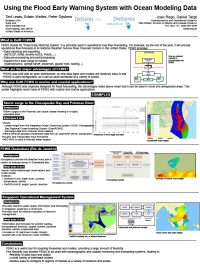CSDMS 2011 annual meeting poster Ted Lewis
Using the Flood Early Warning System with Ocean Modeling Data
Edwin Welles, Deltares-USA Silver Spring Maryland, United States. Edwin.Welles@deltares-usa.us
Peter Gijsbers, Deltares-USA Silver Spring Maryland, United States. peter.gijsbers@deltares-usa.us
Abstract:
The Flood Early Warning System (FEWS) was designed as a hydrologic forecasting and warning system. A major design philosophy of FEWS is to use an open infrastructure to facilitate data import, manipulation, and export from a wide –and expanding – number of data sources. The same can be said of the models that FEWS communicates with. This open infrastructure allows FEWS to be used with novel data sources and models. Given its proven history in hydrologic forecasting, this makes FEWS well suited to modeling and forecasting fluvial influence on coastal and marine systems.
Here we present an example of how FEWS can be extended to use oceanographic data. Our example forecasts stage in the Potomac River, where storm surges, especially during hurricanes, can cause flooding in a densely populated area. We use gridded data from the Integrated Ocean Observing System (IOOS). Data from the Chesapeake Bay Regional Ocean Modeling System (ChesROMS), posted to an OpenDAP server, were accessed from within FEWS. FEWS was used to manipulate the ChesROMS data. For example, the ChesROMS data are disaggregated to produce a time step consistent with available discharge time series, and point data are extracted from the ChesROMS grid at river monitoring sites. The model HEC-RAS is then used to forecast water heights given inputs of stage and discharge. This example illustrates the flexibility of FEWS, and its ability to be used in new areas.
* Please acknowledge the original contributors when you are using this material. If there are any copyright issues, please let us know and we will respond as soon as possible.

